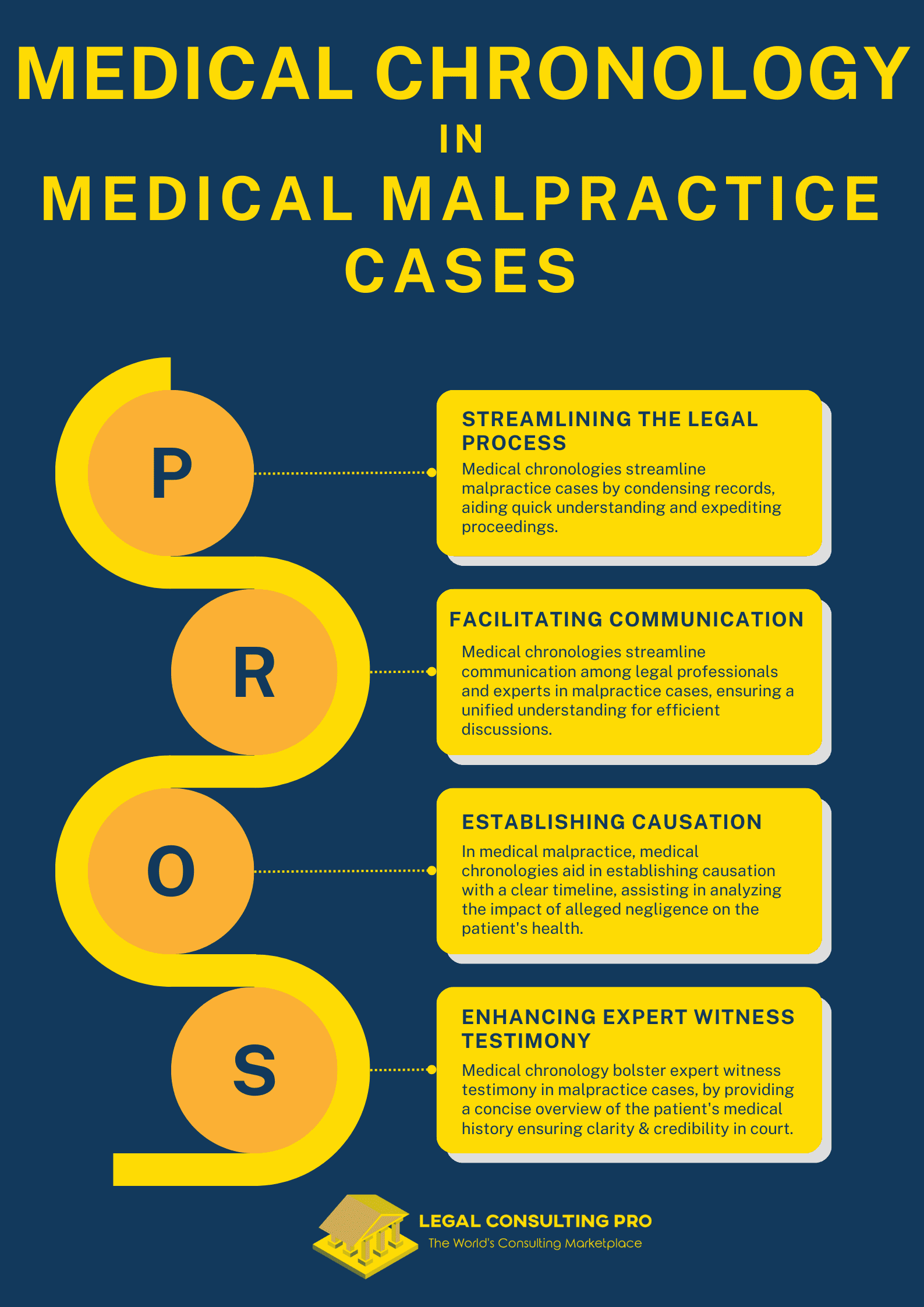In the intricate world of medical malpractice lawsuits, the utilization of medical chronology emerges as a powerful strategy, unraveling the complexities and streamlining the legal process. These chronological summaries play a pivotal role in presenting a compelling case, aiding paralegal services providers and lawyers in navigating through extensive medical records and deciphering intricate healthcare details. In this comprehensive guide, we delve into the profound impact of medical chronologies on medical malpractice lawsuits, exploring their benefits, key findings, and strategies for leveraging these invaluable tools effectively.
What Are Medical Malpractice Lawsuits?
Medical malpractice lawsuits arise when a healthcare professional or a healthcare institution is alleged to have provided substandard or negligent care to a patient, leading to harm, injury, or death. These lawsuits are a subset of personal injury law. They are based on the claim that the healthcare provider deviated from the standard of care expected in their profession, resulting in harm to the patient.
Medical malpractice lawsuits can involve a range of healthcare professionals, including doctors, nurses, surgeons, dentists, and other medical practitioners. The types of alleged malpractice can vary widely, encompassing misdiagnosis, surgical errors, medication errors, birth injuries, failure to diagnose, and more.
Key elements typically present in medical malpractice cases include:
- Duty of Care: The healthcare professional owed a duty of care to the patient, meaning they had a responsibility to provide competent and appropriate medical treatment.
- Breach of Standard of Care: The healthcare provider breached the standard of care by deviating from what a reasonably skilled and competent professional in the same field would have done under similar circumstances.
- Causation: The breach of the standard of care directly caused the patient’s injury or harm. It must be proven that the negligent actions were a substantial factor in causing the harm.
- Damages: The patient suffered damages, which can include physical injuries, emotional distress, additional medical expenses, loss of income, or other losses.These cases are complex and often require expert medical testimony to establish the standard of care, the deviation from that standard, and the causal link between the negligence and the patient’s harm. Medical malpractice lawsuits aim to provide compensation to the injured party for their losses and, in some cases, hold healthcare professionals accountable for their actions.
These cases are complex and often require expert medical testimony to establish the standard of care, the deviation from that standard, and the causal link between the negligence and the patient’s harm. Medical malpractice lawsuits aim to provide compensation to the injured party for their losses and, in some cases, hold healthcare professionals accountable for their actions.
Understanding the Significance of Medical Chronology
In the complex landscape of medical malpractice litigation, establishing a clear and concise narrative is paramount. Medical chronologies condense extensive medical records into a coherent timeline, providing a chronological sequence of events leading up to and following an alleged malpractice incident. This organized presentation facilitates a more efficient review of medical evidence, enabling paralegal services providers and lawyers to focus on crucial aspects of the case. Moreover, medical chronology contributes to better communication among paralegal services providers and attorneys, experts, and other stakeholders, fostering a collaborative approach that enhances the overall efficiency of the legal process.
Benefits of Medical Chronology in Medical Malpractice Cases
Streamlining the Legal Process
Streamlining the legal process in medical malpractice cases is essential due to the complexity and volume of medical records that often span years of a patient’s history. Medical chronology plays a pivotal role in this effort by condensing extensive medical information into a concise and organized format. These chronologies provide paralegal services providers and attorneys, judges, and jurors with a comprehensive yet streamlined overview of crucial details. By presenting key medical events, treatments, and outcomes in an accessible manner, medical chronology facilitates a swift understanding of the case’s essential aspects. This expedites legal proceedings, allowing for more efficient and focused deliberations on the alleged medical malpractice.
Facilitating Communication
Medical chronologies play a central role in facilitating communication among paralegal services providers and attorneys and among experts involved in medical malpractice cases. Serving as a comprehensive reference point, these chronologies ensure that all stakeholders have a clear and unified understanding of the intricate medical history related to the case. This enhanced communication not only promotes collaboration but also fosters synergy among paralegal services providers and attorneys, medical experts, and other involved parties. By providing a structured overview of key medical events, treatments, and outcomes, medical chronology contributes to a shared foundation of knowledge, ultimately streamlining discussions and decision-making processes in complex legal proceedings.
Establishing Causation
In medical malpractice lawsuits, establishing causation is a pivotal challenge. Medical chronologies play a crucial role in this process by offering a chronological overview of the patient’s medical history. This detailed timeline aids in pinpointing when the alleged malpractice occurred, identifying contributing factors and assessing the direct impact on the patient’s health. By presenting a clear sequence of events, medical chronology provides a comprehensive visual aid for paralegal services providers and lawyers, experts, and the court to analyze the causal relationship between the alleged negligence and the resulting harm, contributing significantly to the overall strength and clarity of the case.
Enhancing Expert Witness Testimony
Medical chronologies are vital in enhancing expert witness testimony in medical malpractice cases. These chronological summaries offer a clear and concise overview of the patient’s complete medical history, providing expert witnesses with a comprehensive understanding of the case. By presenting key events, treatments, and outcomes in a structured format, medical chronology empowers expert witnesses to prepare well-informed opinions. This detailed and organized information becomes a valuable reference for experts as they articulate their insights, contributing to the clarity and credibility of their testimony in court.

Tips for Leveraging Medical Chronology in Medical Malpractice Litigation
- Early and Thorough Compilation: Initiate the creation of a medical chronology early in legal proceedings to streamline the process. Thoroughly compile and organize all relevant medical records, ensuring comprehensive coverage of a patient’s history, treatments, and outcomes. This meticulous approach, conducted at the outset, facilitates the development of a detailed and well-structured chronology. Early initiation enhances the efficiency of legal proceedings, providing a solid foundation for paralegal services providers and attorneys, experts, and stakeholders to analyze and present the case with clarity and precision.
- Collaboration with Medical Experts: Close collaboration with medical experts is crucial in crafting accurate and effective medical chronology for legal cases. Leveraging their in-depth knowledge, these professionals ensure precision in capturing medical nuances, interpreting complex records, and identifying crucial details. Their expertise enhances the accuracy of the chronology and brings valuable insights to the legal team, contributing to a comprehensive and compelling presentation of medical evidence in the case.
- Visual Presentation: Incorporate visual aids like timelines, charts, and diagrams when presenting the medical chronologies. These visual representations significantly enhance comprehension, making intricate medical information more accessible to judges and jurors. Utilizing visuals not only simplifies the communication of complex details but also strengthens the overall impact of the medical evidence, facilitating a clearer understanding of the case’s medical aspects in the courtroom.
- Regular Updates: Regularly update the medical chronology to reflect any changes or additions to medical records. This proactive approach ensures that the chronology remains accurate and relevant, aligning with the evolving nature of the case throughout legal proceedings. Timely updates help paralegal services providers and lawyers stay informed about the latest medical developments, reinforcing the credibility and precision of the medical chronologies as a dynamic and reliable tool in the litigation process.
- Clarity and Objectivity: Maintain objectivity throughout the creation of the medical chronology. Present the facts without introducing bias, allowing the chronological sequence to speak for itself. Objective documentation enhances the credibility of the chronology, ensuring that it serves as an impartial and reliable tool for paralegal services providers and lawyers. This approach supports a clear and unbiased presentation of medical events, contributing to the strength of the case without compromising the integrity of the information presented.
- Legal Consulting Expertise: Collaborate with legal consulting experts specializing in medical malpractice cases for the creation of robust medical chronologies. Their expertise and experience can significantly enhance the quality of the chronology, ensuring it meets the specific requirements of medical malpractice litigation. Legal consulting professionals bring a nuanced understanding of legal intricacies, contributing to the development of a comprehensive and compelling medical chronology that strengthens the case and supports legal strategies effectively.
Conclusion
Within the realm of medical malpractice lawsuits, the strategic use of medical chronologies becomes imperative. These meticulously organized timelines not only streamline legal processes but also weave a clear and compelling narrative essential for establishing the crucial elements of a malpractice case. Understanding the significance, benefits, and effective strategies for leveraging medical chronologies empowers paralegal service providers and lawyers to adeptly navigate the complexities of medical malpractice litigation.
Similar blogs:
The Role of Medical Chronology in Legal Cases: A Comprehensive Guide
Understanding the Benefits of Medical Chronology in Personal Injury Litigation













































